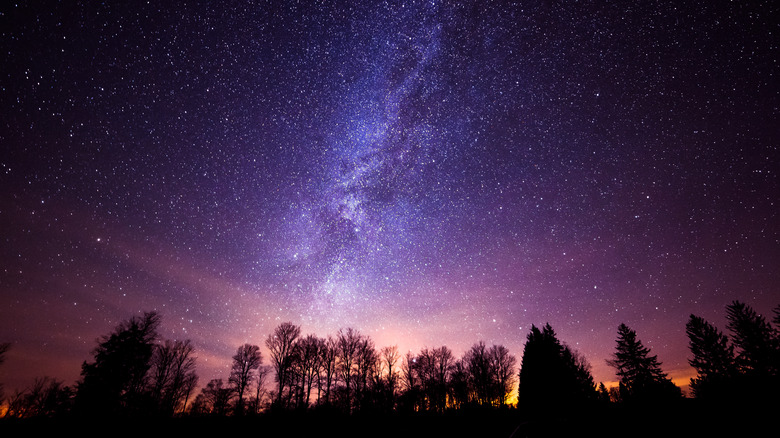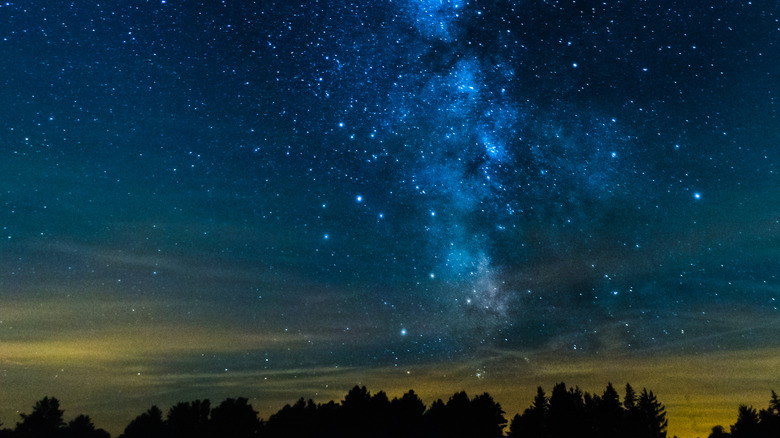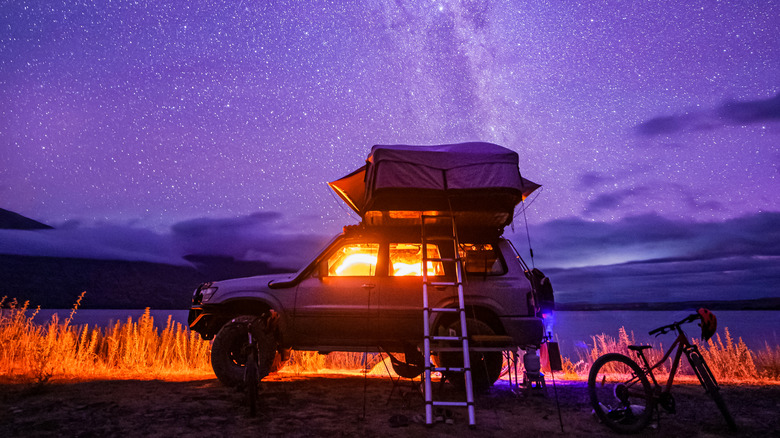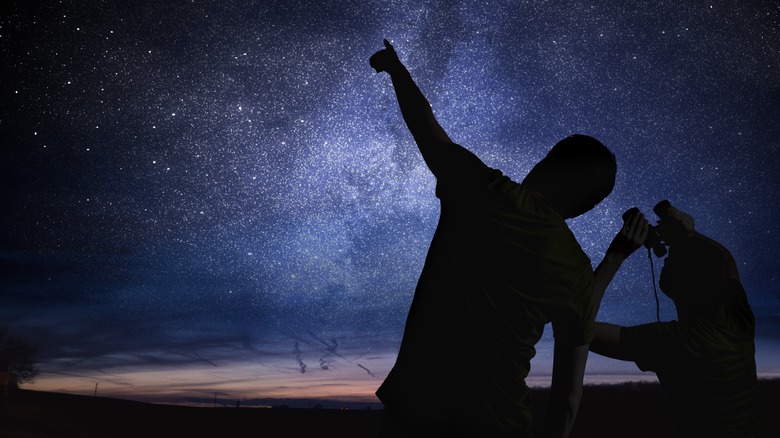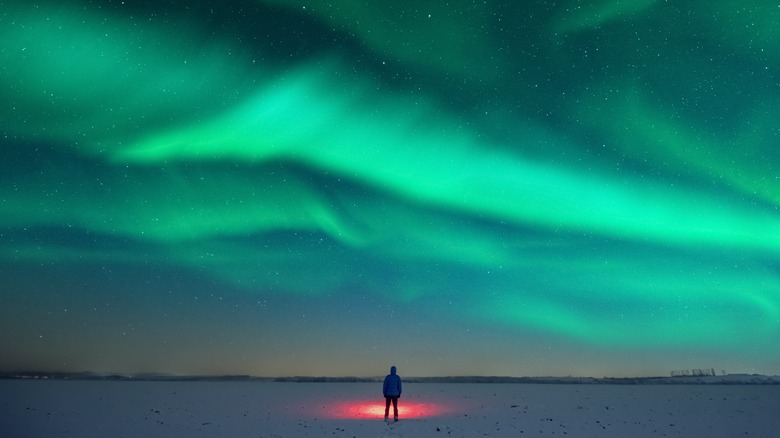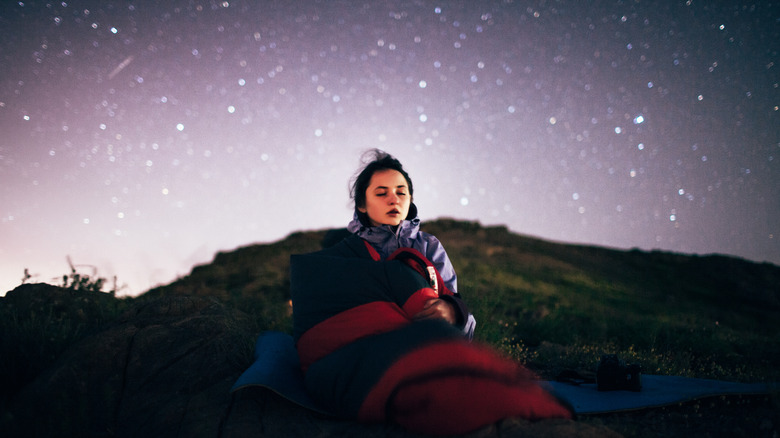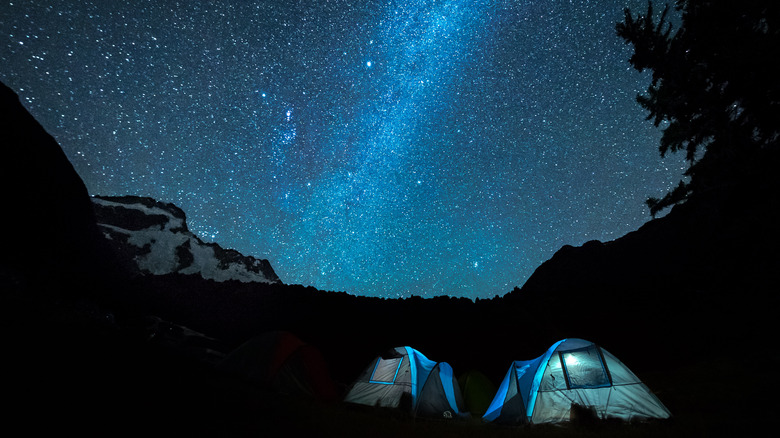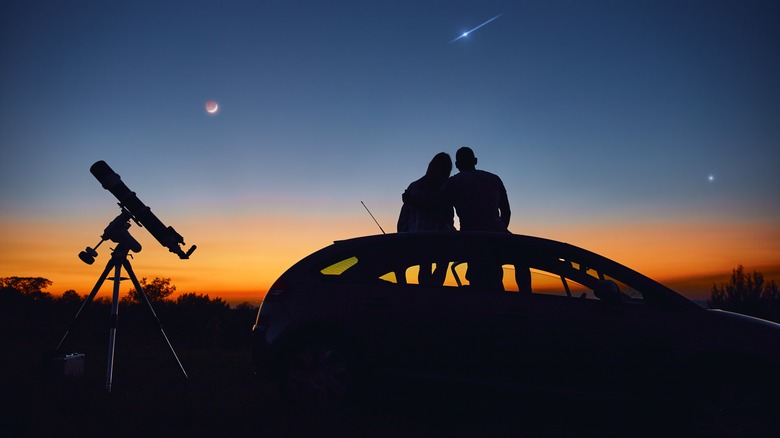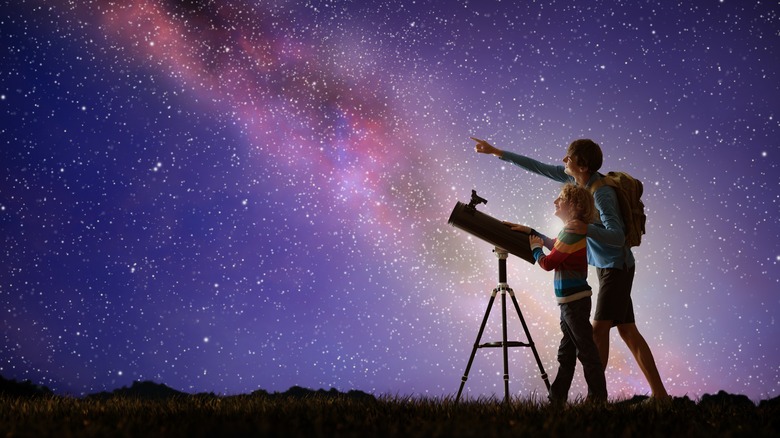A Guide To Stargazing At Cherry Springs State Park
Cherry Springs State Park is one of the darkest, clearest places to stargaze on the East Coast. The park is essentially a huge field on top of a mountain, with not much, save wilderness, in the surrounding area. Its altitude and remoteness create almost perfect stargazing conditions.
You wouldn't think laying under the stars would take a whole lot of planning, but there are a few things you will need to plan ahead for when visiting Cherry Springs. Oh sure, a spontaneous trip under a star-clad sky sounds romantic and downright magical. However, without a little planning, you could arrive at a closed campground under a sky that is full of clouds rather than shining constellations.
Don't worry, though. A star-filled night in Cherry Springs State Park is just a few well-informed choices away. From some very specific flashlight guidelines to when you can actually stay overnight at the park, our guide will help you know what to expect when planning your visit.
What can you see at Cherry Springs?
You'll be amazed at the colors and light patterns that can come out of a sky as black as Cherry Springs State Park. The park is a dark sky reserve, which means it offers a clearer view of our night sky than the vast majority of views elsewhere.
Of course, your night view will be highly dependent on the weather and time of year. If you visit during a cloudy night, then you may be out of luck on spotting stars and you can forget about harder-to-see constellations. Assuming the sky is clear, the Northern Lights are visible here, but Cherry Springs' crown jewel of astronomical wonders is the Milky Way. The park is in an ideal location for an absolutely epic view of our galaxy, and you may even be able to spot our neighbor Andromeda as well.
While it's not the best state to see the Northern Lights, Pennsylvania makes the cut for places in the United States where you can spot the aurora borealis. And, if in Pennsylvania, the park is obviously the place to go to get the best view of the phenomenon. Distant wonders are also visible with specialized equipment, like the Rho Ophiuchi star system and the Helix Nebula. Really, the universe is at your fingertips here.
When to visit Cherry Springs for stargazing
If Cherry Springs State Park is on your travel bucket list, then you're probably (definitely) interested in a celestial experience. April to October is the peak stargazing season at the park, though you will need to pour over weather patterns to help ensure the sky stays clear for your viewing pleasure. Peak season aligns with the best time to see the Milky Way Galaxy, which lights up the sky here beautifully. For the darkest skies, plan your visit for the New Moon. Alternatively, Full Moon nights bring with them a guided night walk through the park.
The campground is closed during the off-season, though the park is open every day of the year for locals or those with other overnight accommodations. If you are planning an overnight visit for mid-April or late October, you should check the reservation site for exact opening/closing dates, as they vary from year to year.
Cherry Springs State Park also holds the Woodsman Show every year in early August. The event is a great time to visit, as it brings exciting daytime activities to the park, like chainsaw wood carving and artisan vendors.
The best areas to stargaze in Cherry Springs
The Night Sky Public Viewing Area is the main observation site and is used by visitors only staying for a few hours at most. It offers good coverage from external light and offers great views for novice and experienced stargazers alike. If you are staying overnight, however, you need to head to the campsite or the Overnight Astronomy Observation Field, where you can watch all night.
For most casual overnight stargazers, the campsite will suffice. You will still have a wonderful night of stars, but there can be some light pollution here. If you want a more professional and pure experience, then the more strict Overnight Astronomy Observation Field is where to go.
For travelers who have opted to rent a nearby cabin, a private viewing area may be included with the accommodation. If this is the case, you still may want to swing by the main viewing site within Cherry Springs if you're a serious stargazer, as you won't get a better lookout at the wide open sky.
How to gain entrance into the park
The actual act of visiting Cherry Springs State Park is pretty straightforward. Though it's remote, it's easy to navigate. Even so, driving will be involved, and those who have flown in to see the stars will definitely need a ride. You won't be able to reasonably Uber your way to the park, as it's a hike and a half to get up the mountain, and the park is over four hours away from the closest airport. No matter where you are coming from, you will need wheels.
Luckily, it is free to get into Cherry Springs and to stay for the day. You will need to make a reservation to stay overnight, though. There is a small reservation fee along with a daily rate that typically falls under $20. There is a use fee for the Overnight Astronomy Observation Field as well.
The remoteness of the park may deter a lot of would-be stargazers, but fortune shines on the distant admirer. The park offers virtual programs throughout the year, which are a great option for those who can't physically make it to the park or those gearing up for a visit.
What to bring and wear
Even though peak season falls in the warmer months, Cherry Springs State Park's top-of-the-mountain location means that it can get quite chilly at night. Most campers know that the key to packing for cold weather is planning to dress in layers, and even if you don't plan on staying overnight, you should bundle up in layers to ensure a comfortable stargazing experience.
Bring blankets and camping chairs, or whatever kind of camping furniture will make you the most comfortable. It wouldn't be remiss to bring a nice portable mattress, as you'll be spending a lot of your time on your back watching the sky. You'll be able to see plenty with the naked eye, but binoculars or a more advanced instrument will allow you to see a whole lot more and get a closer look at the universe's marvels.
You will likely need a light source with you, but you need to be careful with light to not disrupt other gazers. Bringing a red light filter for your flashlight will provide you with light while not obscuring any views of the night sky. Even though you will not have service here, pack your phone! It's still good in an emergency and has capabilities that don't necessarily need service or data.
What not to do at Cherry Springs
Along with offering an amazing celestial experience, it's important to remember that Cherry Springs State Park is, first and foremost, a protected nature site like other government-run parks. All trash and food must be disposed of and cleaned up properly, and most of the park is untamed wilderness, so leave it as you find it.
Open fires are largely prohibited, and campfires within the provided fire circles must be kept minimal. Green lasers are also a no-no, and white light is not allowed in the Overnight Astronomy Observation Field. In other areas, white light should be used as sparingly as possible to preserve the dark sky experience. If you were hoping to enjoy the stars with a drink in hand, you may be a bit disappointed. Alcohol is not permitted in the park, either.
While there may be nothing more cozy than cuddling up with your furry friends under a wide-open night sky, Fido is going to probably need to stay home. You cannot bring pets into any part of Cherry Springs State Park. However, you may be able to find a workaround by booking a pet-friendly, off-park accommodation and leaving them there while visiting the Night Sky Public Viewing Area.
What to know about flashlights and headlights
One of the best ways to have dozens of angry astronomers pin their glares in your direction is to create light pollution. For this reason, you will want to make sure you get your lighting situation figured out before you put it to the test in the dark at Cherry Springs.
You don't want to be stumbling around in the dark, knocking over state-of-the-art telescopes, so bringing a flashlight is a good idea. You do need to modify your flashlight with either a shield or a red light filter. You can also just buy a red light flashlight. Your flashlight should point toward the ground whenever possible.
Cars present another problem entirely for stargazers. Headlights and interior lights are bright, and to be courteous to others, you should try to avoid driving after dark. If you arrive after dark or plan to leave while it is dark, you will need to park in the visitor parking area to avoid lighting up the observation areas. Turn off or cover your interior lights so that when you open your doors, no light obstructs the night. Pro tip: don't lock or unlock your car at night if your lights flash when you do so.
How to stay overnight
Though you cannot stay overnight at the Night Sky Public Viewing Area, there is a range of options for overnight accommodations in and near Cherry Springs State Park. No matter what option you choose, you will either need to make a reservation or register to stay overnight.
The rustic campground requires a reservation and payment. You will use Cherry Springs' own reservation site to book your choice of campsites, all with differing back-in lengths for RVs. The only other overnight area within the park is the Astronomy Observation Field, which does not accept reservations but does require registration once you are within the park itself, offering space on a first-come, first-serve basis.
If neither overnight option provided by Cherry Springs State Park sounds like your cup of tea, you may consider exploring short-term rentals through sites like Airbnb and Vrbo. However, even if these rentals are located near the park, they probably won't offer the same high-altitude vantage point that the park offers.
Amenities at the Observation Field
Cherry Springs State Park's Overnight Astronomy Observation Field is for the seriously passionate, or even professional, stargazers who have their own equipment. There is a fee for using this space, but those who book the area are given a bit more benefits and security while spending the night in uninhibited darkness. Registration is done in person at the site.
A tarp covers the gate once the sun goes down to keep light from entering the sectioned-off space. Both grass and concrete pads are provided for telescopes, and stargazers can choose what suits them the best. Electricity and Wi-Fi are also provided, which is regularly needed for stargazing equipment. Those who opt for the Observation Field will be able to charge their equipment and use any stargazing apps or aids they may have on their phones or laptops. Just remember that the light emitted from screens must be contained and minimal.
Amenities at the campgrounds
Each campsite has a place to build a fire, though campers should strive to make their fire as small as possible to keep light pollution down. Each site features one picnic table per site, if you plan on utilizing it, make sure to clean up after yourself thoroughly and dispose of any food waste properly. All 30 campsites share one RV dump station. Keep in mind that you'll likely be close to other stargazers sharing similar spaces, so you'll need to continue being considerate with the light you put out.
There is no electricity, Wi-Fi, or flushing toilets at the campground. If you choose to stay in this area, you will be participating in some good, old-fashioned camping. Under the night sky of Cherry Springs State Park, though, it's easy to forget about the lack of amenities.
Tips for a safe stargazing adventure
Anytime you are traveling or going somewhere new, you should have some kind of travel safety plan in case something goes wrong. This is especially true when you are going somewhere you won't have phone service, which is a very likely scenario when it comes to Cherry Springs State Park. Like any venture around the wilderness or into the unknown, tell people where you are going. Make a plan, tell your loved ones said plan, and stick to it. If there is a change in plans, try to let someone know where you will be, if possible, and update when you can. Traveling with at least one buddy is a great safety tip, too.
We've already established that Cherry Springs is dark; possibly darker than you've ever experienced. Don't wander off, because you could have a very hard time finding your way back in such conditions. The dark brings cold with it, so come prepared for the elements, and don't panic if you do end up turned around or lost. You will not be alone in the park, so don't be afraid to ask for help in case of emergency.
What to know in case of emergency
You may take precautions and prepare against emergencies, but they still can happen no matter how hard you try to avoid them. Though you'll likely not have cell service, 9-1-1 will still work with a lot of phones. The emergency number is programmed to work off the grid in newer iPhones. If your phone is not able to reach 9-1-1, there is a phone where the RVs check-in that will work. You can also find a park employee for help or find another camper who may have service. Be loud in an emergency about what you need, and people will come.
You should also familiarize yourself with checkpoints within the park, which may help you find your way out in an emergency, and know where the closest hospital is located. Print out directions beforehand, but you can also find some on the bulletin boards throughout the park.
Stargazing equipment and apps
The sky is so dark and open in Cherry Springs State Park that you don't need any kind of equipment to see some out-of-the-world sights, and iPhones these days take pretty great photos. That doesn't mean you shouldn't take the opportunity that the park presents to step up your stargazing game, though. Binoculars and handheld telescopes are very affordable and will give you a closer look at what you've come here to see.
If you really want to step into the shoes of an astronomer, though, upgrading to a full-standing telescope is the move. They come in a huge range of prices with equally ranging features, but the novice looking for a one-and-done experience can spend less than $100 for a serviceable telescope.
Another incredibly accessible option is to download a stargazing app. Make sure to choose one that works offline, like Stellarium and SkyView. Even if you've never seen a star in your life, these aids will allow you to identify and find constellations and other celestial bodies. And half the fun is knowing what you're looking at!
